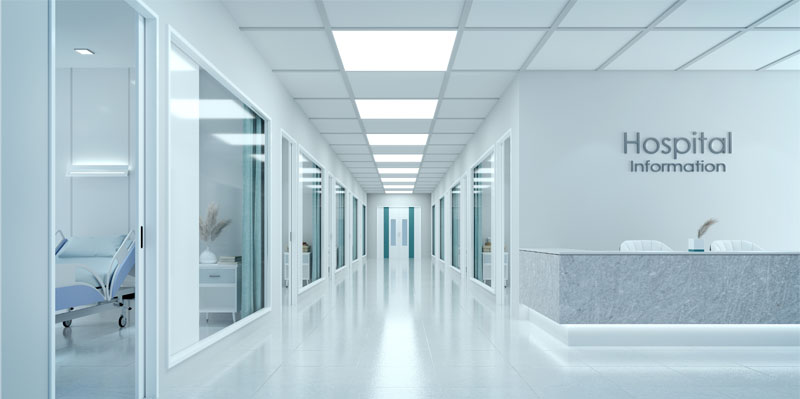In today’s fast-paced world, hospitals and healthcare facilities face the challenge of creating a comfortable and stress-free environment for patients. The patient experience plays a crucial role in their overall well-being and recovery. To address this issue, many hospitals are turning to innovative solutions, such as switchable glass technology, to enhance the patient experience.
This article explores the benefits and applications of switchable glass in hospitals, focusing on how this cutting-edge technology can transform the healthcare landscape.
Why Switchable Glass?
Switchable glass, also known as smart glass or privacy glass, is an innovative glazing technology that can change its light transmission properties on demand. It utilizes electrochromic, photochromic, or thermochromic technologies to alter the opacity or transparency of the glass. By applying an electrical current, light, or heat, the glass can switch between transparent and opaque states, offering instant privacy or openness.
Enhancing Privacy and Comfort in Patient Rooms

Providing On-Demand Privacy
Patient privacy is of utmost importance in healthcare settings. This glass allows patients to control the level of privacy in their rooms with the flick of a switch. By instantly transforming glass walls or windows into opaque surfaces, patients can feel more secure and at ease during their stay.
Reducing Noise and Disturbances
Hospitals can be noisy environments, which can hinder patients’ rest and recovery. This glass, in its opaque state, acts as an effective sound barrier, reducing external noise and disturbances. This feature contributes to a quieter and more peaceful patient room environment.
Controlling Natural Light and Glare
Natural light is beneficial for both patients and medical staff, but excessive glare can be uncomfortable. The smart glass allows precise control of the amount of natural light entering patient rooms, ensuring optimal lighting conditions without causing discomfort or glare.
Transforming Hospitals Waiting Areas With Switchable Glass

Creating Versatile Spaces
Hospital waiting areas can serve multiple functions, from providing comfort to patients’ families to acting as a space for relaxation and reflection. Switchable glass partitions can create versatile spaces that can be easily adapted to various needs, offering patients and their loved ones a more pleasant waiting experience.
Incorporating Digital Signage and Art Displays
Switchable glass can also double as digital signage or a canvas for art displays when in its opaque state. Hospitals can use this feature to communicate important information, educate patients, and create an aesthetically pleasing environment that promotes positivity and healing.
Improving Waiting Times and Patient Satisfaction
With the ability to create private waiting areas, hospitals can enhance patient satisfaction by providing more personalized and comfortable spaces. This can help reduce perceived waiting times, contributing to a positive overall patient experience.
Optimizing Surgical and Treatment Rooms With Switchable Glass
Ensuring Patient Privacy During Procedures
In surgical and treatment rooms, patient privacy is crucial for maintaining dignity and confidentiality. The glass allows medical staff to instantly block the view from outside, ensuring patients’ privacy during sensitive procedures.
Improving Hygiene and Infection Control
This glass can be a hygienic solution for medical environments, as it eliminates the need for traditional curtains or blinds that can harbor germs and bacteria. The smooth and easy-to-clean glass surface supports infection control efforts, enhancing patient safety.
Enhancing the Working Environment for Medical Staff
The well-being of medical staff is vital for providing quality patient care. This glass can create a more pleasant and calming environment in surgical and treatment rooms, contributing to reduced stress levels and increased focus during critical procedures.
Promoting Safety and Security With Switchable Glass for Hospitals

Controlling Visual Access to Sensitive Areas
Certain hospital areas, such as intensive care units and restricted zones, require limited access for safety and security reasons. This glass can obscure the view from the outside, providing an additional layer of privacy and security for such spaces.
Enhancing Emergency Response Preparedness
In emergency situations, quick decision-making is essential. This glass can be used to convert open spaces into private areas for triage or consultations, ensuring effective communication and decision-making during critical moments.
Addressing Patient Elopement and Wandering
This glass can be applied to the windows and doors of patient rooms to prevent elopement and wandering, especially in memory care units or psychiatric wards. The glass can be instantly switched to opaque to minimize visual cues that might trigger such behavior.
Energy Efficiency and Sustainability for Hospitals
Reducing Energy Consumption
This glass helps regulate indoor temperatures by controlling the amount of solar heat gain. By minimizing the need for excessive heating or cooling, hospitals can reduce their energy consumption and lower utility costs.
Harnessing Natural Light for Energy Savings
The ability to control natural light through This glass reduces the reliance on artificial lighting during the day. This energy-efficient feature contributes to greener practices and a more sustainable healthcare facility.
Contributing to Green Building Certifications
Hospitals seeking to achieve green building certifications can benefit from incorporating switchable glass technology into their designs. The use of energy-efficient materials and technologies positively impacts a hospital’s overall sustainability profile.
Addressing Patient-Specific Needs
Catering to Patients with Sensory Sensitivities
Patients with sensory sensitivities, such as autism spectrum disorders, may experience anxiety in overwhelming environments. This glass can create calm and soothing spaces by minimizing sensory stimuli, improving the overall well-being of these patients.
Facilitating Pediatric Care with Interactive Glass
Children can find hospital stays distressing. Interactive switchable glass with engaging content can distract and entertain pediatric patients, making their hospital experience less daunting and more enjoyable.
Assisting Elderly Patients with Smart Glass Technology
Elderly patients often have unique needs, including privacy and ease of access to information. Smart glass features can address these requirements, making the hospital environment more accommodating for the elderly population.
Conclusion
Switchable glass technology presents an exciting opportunity for hospitals to revolutionize the patient experience. By providing on-demand privacy, optimizing room functionality, promoting safety, and contributing to energy efficiency, smart glass can elevate the standard of care in healthcare facilities. As hospitals continue to prioritize patient comfort and satisfaction, embracing innovative solutions like switchable glass will undoubtedly lead to improved patient outcomes and a more positive healing environment.
FAQs
Switchable glass is suitable for all hospital settings, including patient rooms, waiting areas, surgical rooms, and sensitive zones. However, it is essential to assess specific requirements and consult with experts to determine the most suitable applications.
Yes, It is designed with safety in mind. It meets rigorous safety standards and is made from durable materials that are resistant to shattering. In case of power outages, the glass typically defaults to a transparent state, ensuring visibility and safety for patients and medical staff.
Yes, It can be seamlessly integrated into hospital automation systems, allowing for centralized control and management. It can be synchronized with lighting, climate control, and security systems to optimize the hospital environment and enhance energy efficiency.
Absolutely! Its energy-saving properties, such as regulating indoor temperature and reducing the need for artificial lighting, contribute to a hospital's overall energy efficiency and sustainability goals.
Switchable glass in hospitals offers several key benefits, including enhanced patient privacy, improved energy efficiency, better infection control, and a more versatile and patient-friendly environment. Its ability to transition between transparent and opaque states on demand makes it a valuable addition to healthcare facilities.
Is switchable glass compatible with smart building systems?
Yes, this technology can be integrated into smart building systems, allowing hospitals to control the glass remotely and automate its state transitions based on specific triggers or schedules.





